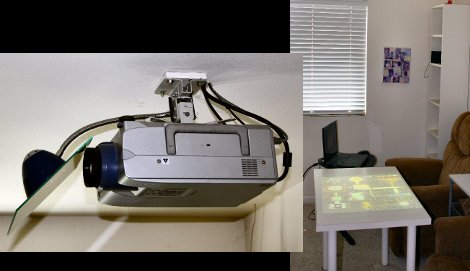
The concept of having a digital gaming table got stuck in [RobotGuy’s] mind over the weekend and he managed to whip this up in no time using materials on hand. He already had a ceiling-mounted projector which just happens to reside immediately above the space occupied by his coffee table. By swapping that piece of furniture out for a white Ikea table, and adding a mirror to the projector he now has the virtual gaming surface he was looking for. The mirror mount is nothing more than a desk lamp that includes a spring clamp and flexible neck. He hot glued the piece of mirror to this, and attached it to the projector’s ceiling anchor. Since rear-projection screens are common, all digital projectors have the ability to mirror and rotate the image being displayed so that it appears on the table in the correct orientation.
We love the look, but this is really only one portion of a digital gaming project. We think the table needs some interactivity. We often see this done using infrared light processed by a webcam. That multi-touch option is not going to work with a standard table since the camera needs to be on the opposite side of a translucent surface. But if you don’t mind using a stylus this IR whiteboard technique would work.





I would want to put a few piezos under the surface and use them to triangulate taps.
That actually seems like a heck of cool idea to do. Know any well documented projects that do that?
It’d be a great opportunity to try that Doppler Effect technique featured a few days ago.
http://hackaday.com/2012/03/21/doppler-effect-lets-you-add-gestures-to-your-computer/
Hotglue? Yea, this won’t last long. Use mirror glue with a high temp rating.
Screw that. A lil’ JB Weld will do the trick.
It bothers me a bit how it seems most hack geeks ignore the really good(read that as cheap) stuff like JB Weld and Epoxy Putty. Mirror glue is crap.
Its possible to look at the shape of the shadows created by your hand to determine when you touch, there was a microsoft research video about 5 years ago about this.
I didn’t find the talk on it, but here is a demo of it.
http://www.youtube.com/watch?v=_07znSzLWr0
I wrote some software years ago for this using OpenCV, but gave up after a while. I did however get it to the point where I could point the webcam at a wall and it could recognize when and where I was touching. All I really needed to do was patch it into a projector system, but mounting the projector and camera and getting it all aligned with the right mirrors and everything just slowed me down. I had high ceilings which didn’t help.
I wish I had a 3D printer back then, I probably would have done it!
But the other reason I didn’t do it was that I assumed someone would release a product based on that soon. I’m surprised that hasn’t really happened yet.
I absolutely LOVE the idea of the digital gaming table – but how does the whole game experience work? Do you still use physical game pieces, and more importantly cards? I’m sure I could do some googling myself, but anyone got nay good links to demos?
I actually have a frosted glass table. With these tables you can pull this trick from the bottom instead of the top. As added feature you could put a camera from the top and “see” items on the table without projecting on them.
Just curious, how did you do this? I have a frosted glass table and a projector, but the throw on the projector I have isn’t short enough.
Haven’t tried using a mirror yet. What was your approach? Or do I simply need a short throw projector?
If ever there was a reason to do a kinect hack…
hole in the table + FTIR with a few diffuser sheets could work,
http://wiki.nuigroup.com/FTIR
diffuser sheets would let the image “project” onto something and allow the ir to still been seen from under the table.
i did one years ago but with an lcd, so not sure how a projector would go as you would normaly place it under the table aswell.